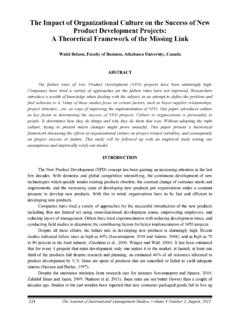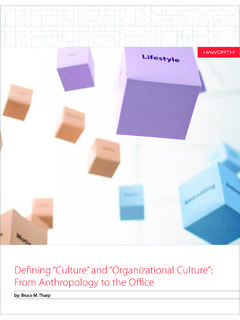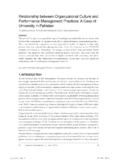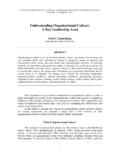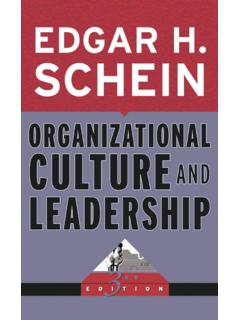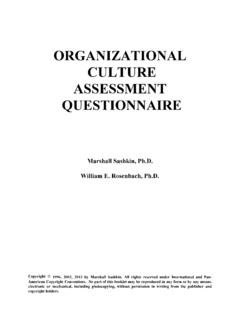Transcription of Corporate Culture and Its Impact on Strategic Change
1 1230 Peachtree St., Suite 1000, Atlanta, GA 30309 TEL Culture and ItsImpact on StrategicChangeResearch and experience fromODR Culture the way we do things around here provides guidance, whether intentional ordefacto, on what is done (or is not), how it is done (if it is), and why it is or isn t done. Culturepermeates every organization, and has the ability to either support or destroy even the mostcritical Change power of Culture is an important consideration when planning Change . This paper will helpyou understand the dynamics of organizational Culture and what contributes to supporting orobstructing Change initiatives. It will also address whether or not to attempt shifting a Culture ,and how it should be approached if such an endeavor is how Culture is formed and knowing how and when to take it on are essentialfoundations to successful strategy execution.
2 You can deliver on transformative changepromises only to the extent that you build a supportive Dynamics of CultureWhile there are many viable definitions of organizational Culture , within this paper it is importantto work with a definition that centers on the relationship of Culture to major Change . In thiscontext, Culture is defined asthe patterns of mindsets and behaviors shared by people in anorganization. Thus, an organization s Culture consists not only ofwhat is done; it Culture is, in effect, an organizational self-concept roughly analogous to anindividual s personality. Like its human counterpart, an organization s self-image develops overa long period of time, although the basic elements typically coalesce during the organization sformative years. A company s Culture is actually an aggregate of subcultures that havedeveloped in response to unique challenges faced at various times by different groups withinthe organization.
3 This is why Corporate Culture is inherently so multifaceted and Culture and Its Impact on Strategic Change , 2010, Conner Partners. All rights characteristics are crucial for understanding the relationship between Culture and Change :x Culture comprises two components mindsets and behaviorsx Culture is sharedx Culture is self-reinforcingCulture s Two Components: Mindsets and BehaviorsAn organization s Culture is lived through themindsets andbehaviors of its employees. Theprevailing mindsets and behaviors of an organization help people understand what actions areconsidered appropriate or inappropriate. This affects daily business operations on two levels:xConscious observable, intentional, and directinfluences on things like goals, policies, proceduremanuals, and Corporate philosophy statements;because they are visible, these influences may beeasier to Change than those that are unconsciousxUnconscious hidden, unintentional, and indirectinfluences on such things as informal ground rules,unofficial guidelines, or the way things actually aredone vs.
4 The formal processes; these influences aredifficult to Change because they lie below the surfaceof our awareness and/or we may be reluctant todiscuss them openlyFor the most part, organizational cultures evolveunconsciously. They are generally unplanned, reacting toshort-term demands, rather than according to a long-termview. Over time, mindsets and behaviors develop to meetcurrent challenges; subsequently, the successful onesbecome reinforced. If, for example, a behavior pattern of lay low; this Change will pass isdemonstrated and numerous Change efforts fail to deliver on their promises, a Culture of passiveresistance is likely to become embedded. Eventually, mindsets and behaviors are taken forgranted and become unconscious. Once this occurs, these now-familiar mindsets and behaviorsare no longer questioned, becoming business as models, values, beliefs, preferences, and attitudes combine to form mindsets themental and emotional structures that guide perceptions, interpretations, and actions.
5 The factthat actions are driven by mindsets places mindsets at the root of Culture Change , and explainswhy a focus on actions alone leads to unsustainable are two key elements of a mindset:x Frame of reference the way an individual makes sense of situationsx Priorities the relative importance and value of various optionsFrame of Reference:Each individual has a unique way of comprehending the world. Somepeople, for instance, are optimists, and focus primarily on the positive aspects of are pessimists, and focus primarily on the negative. A person s professional background,past experience, education, etc. all influence the way he or she views circumstances. TheCorporate Culture and Its Impact on Strategic Change , 2010, Conner Partners. All rights of all the various parts of an individual s understanding of the world makes up his orher frame of reference.
6 In organizations, consistent patterns of interpretation, supported byorganizational communication, rewards, etc., lead to shared frames of reference the basis fororganizational :When people encounter situations, their priorities guide what they pay attention to,what they value, and ultimately, what actions they take. People face a variety of choices as theygo through their day: Should I eat lunch or exercise? Return this phone call or send an email?Take the time or risk to raise this issue or let it slide? The pattern of choices people make arereflections of the things they place the highest value on the things they see as most pattern of shared priorities within an organization, and, therefore, the pattern of choices madeabout how to spend time and energy, is another important part of the , as interpreted through frames of reference and priorities, drivebehaviors within theorganization.
7 Behaviorsare observable actions that constitute the way people actually operateon a daily basis. Whereas mindsets reflect intentions that are often difficult to discern, behaviorscan be verified in a more objective manner. Where people park, whom they do and don t talk to,what they wear to the office, whether they interact with customers in terms of short-termtransactions or long-term relationships, how decisions are made, and how conflict is managedare all behaviors associated with an organization s summarize, mindsets consist of shared frames of reference that lead to shared an organization, they serve, along with behaviors, as foundations for understanding andinfluencing Culture . Behaviors, in and of themselves, provide significant information. However,without addressing mindsets (frames of reference and priorities) as well, a completeunderstanding of the Culture will be Is SharedAlthough the combination of these conscious and unconscious elements can be blatant orsubtle, Culture is always part of organizational life.
8 It s possible to be unclear about what aculture reinforces, but it is impossible for an organization not to have one. It provides thecohesiveness people need to function together and is conveyed through a number of practices,including the following:x Oral and written communications, such as presentations and emailx Organizational structure, as reflected by line and staff relationshipsx The way power and status are defined, both formally and informallyx What is measured and controlled, such as time, productivity, safety, and qualityx Formal policies and procedures found in employee manuals and official communicationsx Reward systems, such as compensation plans and supervisory techniquesx Stories, legends, myths, rituals, and symbols, such as company heroes, award banquets,and Corporate logosx The design and use of physical facilities, including how space is allocated and furnishedWhile Culture is shared, it is not the same across all parts of the organization.
9 Rather, a closelook will always uncover a series of subcultures. Ideally, these are consistent with one another,and with the overall organizational Culture . For example, if the sales force focuses on buildingCorporate Culture and Its Impact on Strategic Change , 2010, Conner Partners. All rights relationships, Customer Service should not approach customer interactions as purelytransactional. At the same time, in well-functioning cultures, each subculture reveals its ownmindsets and behaviors that allow its members to function together, and to relate to other areasof the organization. The sales force may invest in significant face-to-face meetings with theirclients in order to propose specific solutions to their needs. Customer Service, on the otherhand, may work remotely to solve specific problems as expeditiously as Is Self-ReinforcingWhether the influence is unstated or overt in nature, a corporation s cultural mindsets andbehaviors serve as a powerful means for defining, justifying, and reinforcing ongoing businessoperations.
10 This self-reinforcing cycle is depicted in the provides ways forpeople to understandimportant decisions. Based onthis understanding,expectations develop that limitpossible responses. Thoseresponses cause people tomake certain decisions andbehave in accordance withthose expectations, confirmingand reinforcing the Culture soriginal patterns. This processbolsters a strong corporateidentity. However, it can alsorestrict the introduction of newmindsets and behaviors thatmay contribute to success in achanging s Impact During ChangeCulture the way things are around here is often beneficial to organizations during periods ofrelative stability. After all, Culture is self-reinforcing; it operates in ways that ensure its owncontinuity. Change is best defined as a disruption of people s expectations.

